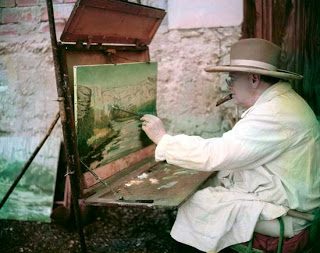
All wrapped up
Last week I visited Blenheim Palace and went round an exhibition about the life of Winston Churchill. It is a place about which he said ”At Blenheim I took two very important decisions; to be born and to marry. I am content with the decision I took on both occasions.”
Part of the exhibition focused on one of his favourite pastimes – painting and I discovered that through a friendship with Joyce Hall a number of his paintings were produced as greeting cards for Hall’s company.
I decided to find about more and see if there a brand story there.
Rather than a tale about Churchill’s paintings, I found one about the birth of wrapping paper.
All wrapped up
Japanese furoshiki, the reusable wrapping cloth still in use today, has been around since the Edo period. (1603 – 1868). The similar Korean bojagi dates from the Three Kingdoms Period, possibly as early as the first century A.D.
In the west, using paper as a covering for gifts has a shorter history and one skewed to the wealthier end of society.
Upper-class Victorians regularly used heavy, elaborately decorated paper, topped with ribbons and lace to wrap and ‘conceal gifts’, especially at Christmas. The less wealthy parts of Victorian society couldn’t have afforded the paper but that didn’t really matter too much as their limited resources didn’t even stretch to buying each other Christmas presents.
By the early 20th century, Christmas and other gifting occasions had increased and the thick, unwieldy paper used by The Victorians had given way to cheaper and easier to use plain one-coloured tissue paper, most often red, green, or white.
 In 1917, however, necessity was to be the mother of invention and the future of wrapping and wrapping papers was to be changed irrevocably
In 1917, however, necessity was to be the mother of invention and the future of wrapping and wrapping papers was to be changed irrevocably
A pair of brothers, Joyce (J.C.) and Rollie, were running a stationery store in Kansas City, Missouri. Business was good in the run up to Christmas – so good, in fact, that they ran out of their standard tissue paper.
They decided that they couldn’t rely on their father’s, an itinerant preacher, maxim “The Lord will provide” but should follow J.C.’s mantra instead. His belief was that “It’s a good idea to give the Lord a little help.”
Searching through what they had to hand, they came across a stack of “fancy French paper”. Paper meant not for display, but for lining envelopes. They decided to put it on sale and price it at $0.10 a sheet. They quickly sold reams of the pretty papers.
As J.C. was to say later “the decorative gift wrapping business was born on the day Rollie placed those French envelope linings on top of that showcase.”
During the holiday season of 1918, the brothers decided to see if their idea was more than a one year wonder and again offered the lining papers as gift wrap, this time priced at 25c for 3 sheets. Again, the sheets sold out.
So in 1919, confident that there was a market, the brothers began producing and selling their own printed decorative papers, designed for the sole purpose of wrapping gifts.
![]() The brothers’ name was Hall and their brand was Hallmark and for years they had the gift paper market all wrapped up.
The brothers’ name was Hall and their brand was Hallmark and for years they had the gift paper market all wrapped up.